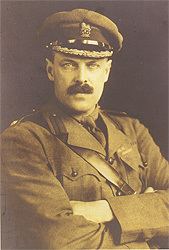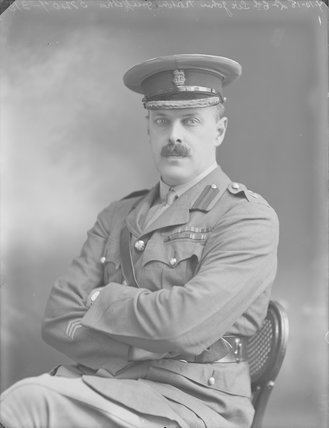Rank Lieutenant colonel | Died September 27, 1930 Name John Norton-Griffiths | |
 | ||
Nickname(s) "Empire Jack" or "Hell-fire Jack" Born 12 May 1875Somerset ( 1875-05-12 ) Battles/wars Second Matabele WarSecond Boer WarFirst World War Other work Member of Parliament, Director of Arsenal Football Club, founding member of the Royal British Legion Role British member of Parliament Battles and wars Second Matabele War, Second Boer War, World War I | ||
Place of burial Surrey, United Kingdom | ||
Lieutenant-Colonel Sir John Norton-Griffiths, 1st Baronet, (13 July 1871 – 27 September 1930) was an engineer, British Army officer during the Second Boer War and the First World War, and a Member of Parliament.
Contents
- Early life
- Military career in Africa
- Marriage and family
- Engineer and MP
- First World War
- Tunneling companies
- Oilfield sabotage
- Last years in Egypt
- References

Early life
John Norton-Griffiths was born John Griffiths in Somerset on 13 July 1871. He was the son of John Griffiths, a clerk of works at St Audries Manor Estate, West Quantoxhead. He had an unsettled youth and left home at the age of 17. After a generally wasted education he spent a year, in 1887–1888, as a trooper with the Life Guards. before travelling to the colony of Natal and shortly on to Transvaal, where he worked as a 'sub-manager' at a gold mine at the age of 17.
Military career in Africa
In 1896 on the outbreak of the Second Matabele War he joined Lieut.-Colonel Edwin Alderson's Mashonaland Field Force, then in 1897 was commissioned into the British South Africa Police. In the Second Boer War, he served briefly with Brabant's Horse, then as Captain Adjutant to Lord Roberts' bodyguard.
Marriage and family
In 1901, Norton-Griffiths married Gwladys Wood. Together they had four children:
Sir John was a keen supporter of Liverpool football club and was a director of Arsenal Football Club between 1928 and 1930.
Engineer and MP
Norton-Griffiths was awarded contracts to carry out major engineering projects in Africa and South America. These included work on the first 197 km of the Benguela Railway in Angola between 1903 and 1908.
He was elected to Parliament in 1910 and was until 1918 the Conservative Party's MP for Wednesbury, Staffordshire. From 1918 until 1924 he was the Conservative MP for the Wandsworth Central constituency, London.
First World War
In 1914 at the start of the First World War, Norton-Griffiths raised the 2nd King Edward's Horse at his own expense and was commissioned major in the regiment. Using the experience from a successful engineering career, Norton-Griffiths built many fortifications for the Entente on the Western Front. An enigmatic figure, Norton-Griffiths took to touring the trenches in a battered Rolls-Royce loaded with crates of fine wines.
Tunneling companies
In early December 1914, Norton-Griffiths wrote to the War Office that his tunnelling workers could be useful for the war effort, but his letter was not acted upon. However, on 20 December 1914, German sappers placed eight mines beneath the positions of an Indian Brigade in Givenchy-lès-la-Bassée. The detonation and follow-up attack wiped out the entire company of 800 men, and following further attacks, it was evident by January 1915 that the Germans were mining to a planned system. Lord Kitchener, contacted Norton-Griffiths on Friday, 12 February 1915, and by the end of the month eighteen "Manchester Moles" sewer men were in France as founding members of 170 (Tunnelling) Company, Royal Engineers.
Oilfield sabotage
In late 1916 he was sent to sabotage the Romanian oil fields ahead of a German advance. Colonel Norton-Griffiths used such techniques as dumping cement down the wells, filling tanks with nails, and emptying storage wells and then setting them on fire. He was able, almost single-handedly, to destroy seventy refineries and 800,000 tons of crude oil. General Ludendorff of the German army was later quoted as saying, We must attribute our shortages in part to him. German efforts later got some of the Romanian fields back online for the war effort, but they were never able to recover fully.
A more sceptical view of the activities of 'Empire Jack' was expressed by career diplomat Lord Hardinge of Penshurst. He wrote: "[In 1916] we had sent a special mission to Roumania under Col. Norton-Griffiths M.P. to destroy both the oil wells and the supplies of grain. Whether the mission succeeded may be judged by the fact that within six months all of the wells that had been destroyed were in working order and large supplies of oil and grain dispatched to Germany and Austria. But the head of the special mission received a K.C.B. for his efforts!".
He was awarded the Distinguished Service Order in 1916.
He changed his name by deed poll in 1917, taking the additional surname "Norton".
He was knighted in 1917 and promoted lieutenant colonel in 1918 (although he had temporarily also held the rank in 1916), and made a baronet in 1922.
Last years in Egypt
On 27 September 1930, while in Egypt negotiating details of the Aswan Dam heightening contract, Sir John took a rowboat from the beach of the Casino Hotel near Alexandria, Egypt. Sometime later, the boat was found empty, and a search party was launched. They soon retrieved Sir John's body, floating in the water, with a bullet wound through the temple. No weapon was found, but the coroner's court gave a verdict of suicide. His body was brought back to England and he was buried at Mickleham, Surrey, on 18 October 1930. He was 59 years old.
His widow Gwladys survived him until her death, aged 101, in 1974.
